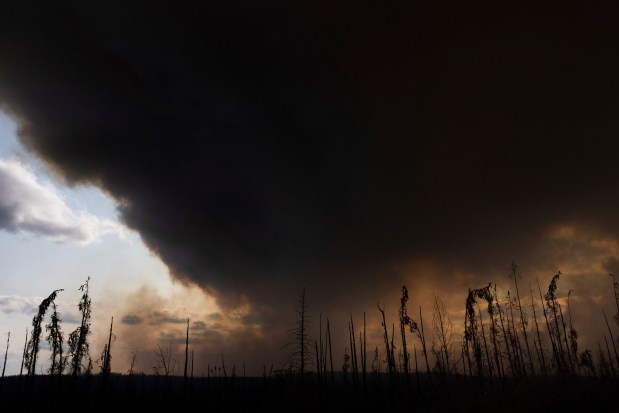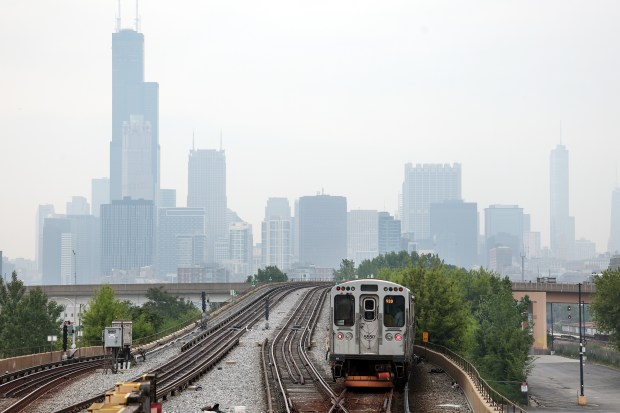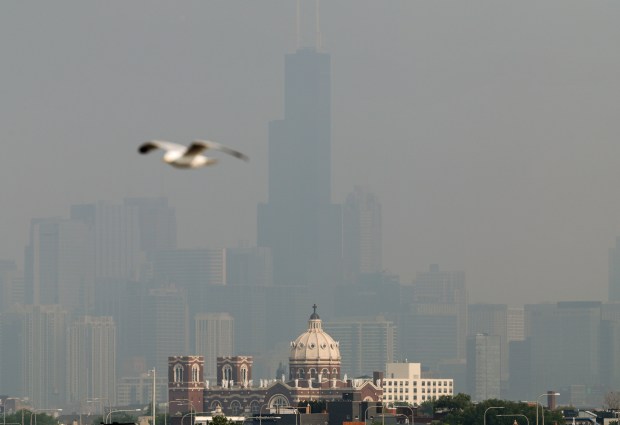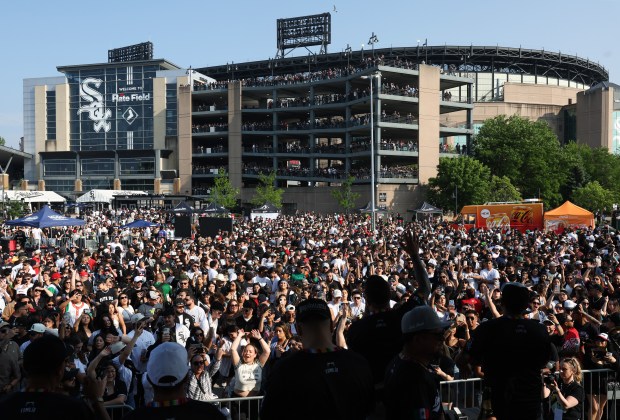Tiny, airborne smoke particles blowing in from Canadian wildfires resisted dispersal from a steady, light rain across the Chicago area Wednesday, concentrating even more Thursday to reach levels unhealthy for the general public. The smoke pushed northeast Illinois into its third day in a row of bad air quality Friday and the state into its first two air pollution action days of the year.
Chicago’s air quality was ranked the worst in the United States on Thursday, according to Swiss air quality technology company IQAir. At one point during the day, The Washington Post reported, the city had the second-worst air quality among the world’s major cities.
“Whatever pollutants were in the air (Wednesday), because of the rain, got suppressed and deposited on the ground. But the wildfires are still happening in the north,” said Ashish Sharma, a professor of atmospheric sciences at the University of Illinois at Urbana-Champaign, whose research focuses on climate and air quality modeling. “It is sending smoke continuously. Rain would have offset the past smoke, but it won’t offset the new smoke.”
Before the summer even officially begins, Chicagoans have already encountered their fair share of nasty particles in the air. In May, a rare dust storm enveloped the city in agricultural sediment. This week, hazy skies are reminiscent of the intense Canadian wildfires of 2023, which made Chicago the second-most-polluted major city in the country that year.
The smoke reaching the Midwest now mostly originates from fires that have been raging northwest of the provincial capital of Winnipeg in Manitoba since mid-May.
Some may be wondering — will it be a summer of days spent indoors? Will the current stretch end or will the smoke stay in the area for weeks?
“It’s hard to tell,” said Zac Adelman, executive director of the Lake Michigan Air Directors Consortium, an air quality research nonprofit. “And it’s hard to forecast what’s gonna happen, you know? I don’t want to catastrophize and say this is going to lead into a summer where we’re not going to be able to go outside.”
On Thursday and Friday, at least, that was the recommendation. The Illinois Environmental Protection Agency urged residents in Cook, DuPage, Kane, Kendall, Grundy, Lake, McHenry and Will counties to limit their time outdoors. By midafternoon Thursday, particulate matter levels in the Chicago area had reached an index of 165 on a scale of 500, which is considered unhealthy for the general public. Friday is expected to be similarly bad, and the EPA extended its air quality alert through the end of the day Friday.
Levels between 200 and 300 are “very unhealthy,” and anything between 300 and 500 is “hazardous.” Wednesday levels remained solidly between 101 and 150, meaning air quality was unhealthy only for sensitive groups.
Bad air the ‘new normal’?
As climate change intensifies, concerns grow about air quality events that disrupt daily life becoming the norm. Dust storms are mostly linked to farming practices that leave soil uncovered and ready to be blown away. However, when it comes to wildfire smoke, scientists say climate change from human activities is making conditions like drought more common, thus increasing the size, frequency and severity of wildfires.
“What we are seeing is that wildfire season is getting prolonged. It’s starting early, and it might end late,” Sharma said. “So that’s of big concern for us. Especially if and when the weather pattern starts stagnating, then we will be trapped with a lot of smoke, especially in the Midwest and Chicago, and the Great Lakes region. That might deteriorate the air quality further.”
Wind patterns also add a layer of unpredictability to the reach of bad air from intensifying, longer-lasting wildfires.
For instance, in summer 2023, a weather system moving counterclockwise pushed air from wildfires across Quebec and Ontario in eastern Canada toward the Great Lakes. A total of 37 million acres were lost to the fires that year. Last summer, fires in British Columbia and Alberta did not blow particulate matter into the Midwest because jet streams carried that smoke eastward and northward, Sharma said. It was also a less intense wildfire season, with just under 13 million acres burning.
In 2025, 6.5 million acres have burned as of Thursday, according to the Canadian Interagency Forest Fire Centre.

“The bottom line is, it depends on the wind flow and the patterns and where the fire started, and so on,” Sharma said. “It’s not that if wildfires are happening a lot, we will be impacted — it depends. Maybe a smaller wildfire in comparison to historical (ones) might be a lot worse for us. Or a large fire, if the plume is not in our direction, might be a lot worse at some other location.”
The air directors consortium uses satellite imagery to understand air pollution at all levels of the atmosphere in the Great Lakes region. Most summer days, Adelman said, they can see smoke overhead.
“The real challenge is, how do you predict when it’s going to get to the surface?” he said. “Because there’s somewhere in North America that’s burning at all times, and it’s loading the upper atmosphere with smoke and particles.”
Forest fires produce fine particulate matter, but direct human sources like vehicle exhaust and industry emissions also release these particles — known as PM2.5 for being 2.5 micrometers or smaller, about 30 times smaller than the width of a strand of human hair. So baseline levels of pollution can be tamped down by regulations on tailpipe emissions, power plants and factories, and more.
Earlier this year, however, President Donald Trump’s administration announced it was launching a set of deregulatory actions that included a “reconsideration” of a decision under former President Joe Biden last year that had tightened annual air quality standards for PM2.5 from 12 to 9 micrograms per cubic meter of air.
In February, the Illinois EPA found that the Chicago metropolitan area hadn’t met the Biden-era federal air quality standards from 2021 to 2023, the most recent three years of data.
Stricter truck pollution rule would prevent 500 deaths a year in Chicago region, study shows
Who is at risk from smoky air?
People most vulnerable to experiencing health effects from PM2.5 pollution levels like Thursday’s include those with respiratory or cardiovascular disorders, children, teens and seniors, as well as adults who are active outdoors. People of lower socioeconomic status who live in heavily industrialized zones already burdened by localized pollution are also more vulnerable to adverse health outcomes during widespread events.

Symptoms to look out for include wheezing, coughing, a fast heartbeat, fatigue, chest pain and shortness of breath, according to the Illinois Department of Public Health.
Initially, PM2.5 may cause burning eyes and a runny nose. But once in the deepest portions of the lungs, it can cross into the bloodstream, messing with blood chemistry and causing heart stoppages. Fine particulate matter has also been linked to premature births, diabetes and even dementia, according to scientists.
How to help and stay safe
On action days — which the Illinois EPA calls when air quality is at least unhealthy for sensitive groups for two or more consecutive days — officials also urge residents to limit their contributions to pollution levels.
Activities to avoid include driving, idling cars, using gasoline-powered equipment like lawnmowers or leaf blowers outdoors, and smoking, frying or broiling food, burning candles or incense, and using a gas stove indoors.
Health officials also recommend conserving energy, using environmentally friendly household and cleaning products, and running a portable air purifier or a central air conditioning system with the fresh air intake closed or set on recirculate. Those who can’t avoid outdoor activities can wear an N95 or N100 mask to protect their lungs.

The city’s Office for Emergency Management and Communications is urging Chicagoans without access to properly ventilated or safe indoor conditions to use public libraries, senior centers, Chicago Park District facilities and the Chicago Cultural Center during hours of operation, or the six community service centers that will be open on Friday from 9 a.m. to 5 p.m. These are the Englewood Center at 1140 W. 79th St., the Garfield Center at 10 S. Kedzie Ave., the King Center at 4314 S. Cottage Grove, the North Area Center at 845 W. Wilson Ave., the South Chicago Center at 8650 S. Commercial Ave., and the Trina Davila Center at 4312 W. North Ave.
Air quality forecasts are available at AirNow.gov. Residents can subscribe for free to receive alerts through the EnviroFlash.info website.
The Associated Press contributed.




